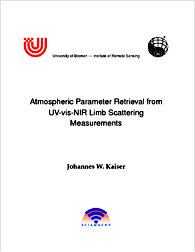| dc.contributor.author | Kaiser, Johannes W | |
| dc.date.accessioned | 2010-10-12T19:29:53Z | |
| dc.date.available | 2010-10-12T19:29:53Z | |
| dc.date.issued | 2001 | |
| dc.identifier.uri | http://hdl.handle.net/11858/00-1735-0000-0001-3226-2 | |
| dc.description.abstract | The hyperspectral UV-vis-NIR spectrometer SCIAMACHY will be launched aboard the European satellite Envisat. Its limb measurements will provide vertically resolved profiles of trace gases and other atmospheric parameters. No retrieval algorithms and radiative transfer models have been established for these measurements yet.In this thesis, a unique, fast radiative transfer model for UV-vis-NIR limb radiances has been developed, implemented, and validated. It takes into account the sphericity of the atmosphere and up to two orders of scattering and surface reflection. The weighting functions for all parameters are calculated from analytical formulae. A realistic instrument model with field-of-view integration and signal-to-noise computation and retrieval algorithms have also been implemented. All have been combined in the new program package SCIARAYS. The package has been applied for the characterisation of the limb measurements in several ways:The simulated weighting functions agree well with those due to full multiple scattering. Thus they may be used to calculate theoretical precision estimates and averaging kernels. In conformance with this, test retrievals with approximate weighting functions converge correctly. Therefore, the approximate weighting functions of SCIARAYS are well suited for retrievals from SCIAMACHYś limb measurements.Detailed theoretical retrieval precisions have been calculated for SCIAMACHYś trace gas targets. The conclusion is that a UV-vis-NIR limb sensor like SCIAMACHY is well suited for studying the vertical structure of the stratosphere and also of the upper troposphere above cloud top.Further investigations show that the vertical resolution of retrievals from SCIAMACHYś limb measurements can be improved beyond its geometrical limits. As a trade-off for better vertical resolution, the retrieval precision gets worse. Thus O3 profile features with 1km vertical extent will be detectable with a precision of 20-30%. | |
| dc.format.extent | 247 S. | |
| dc.format.mimetype | application/pdf | |
| dc.language.iso | eng | |
| dc.publisher | Univ. Bremen | |
| dc.rights.uri | http://e-docs.geo-leo.de/rights | |
| dc.subject.ddc | 551.5 | |
| dc.subject.ddc | 550.28 | |
| dc.subject.ddc | 550 | |
| dc.subject.gok | TUA 850 | |
| dc.subject.gok | TQI 000 | |
| dc.subject.gok | TVA 210 | |
| dc.title | Atmospheric parameter retrieval from UV-vis-NIR limb scattering measurements | |
| dc.type | monograph | |
| dc.subject.gokverbal | Satellitenmeteorologie | |
| dc.subject.gokverbal | Geophysikalische Satellitenfernerkundung | |
| dc.subject.gokverbal | Chemische Zusammensetzung der Atmosphäre {Meteorologie} | |
| dc.identifier.doi | 10.23689/fidgeo-406 | |
| dc.identifier.ppn | 358553369 | |
| dc.type.version | publishedVersion | |
| dc.relation.collection | Geophysik | |
| dc.description.type | thesis | |


